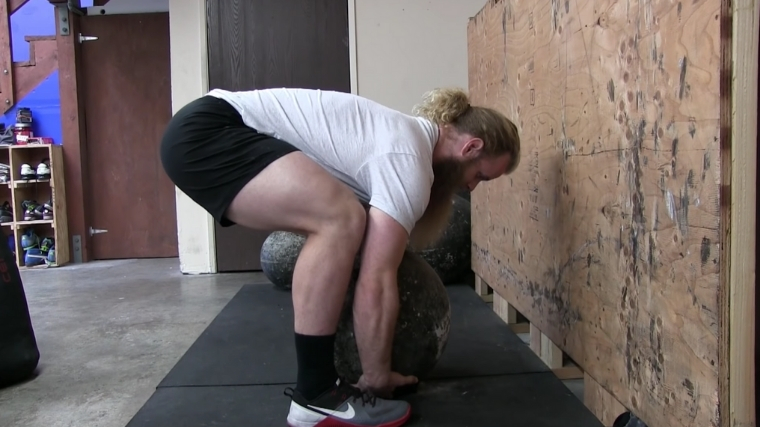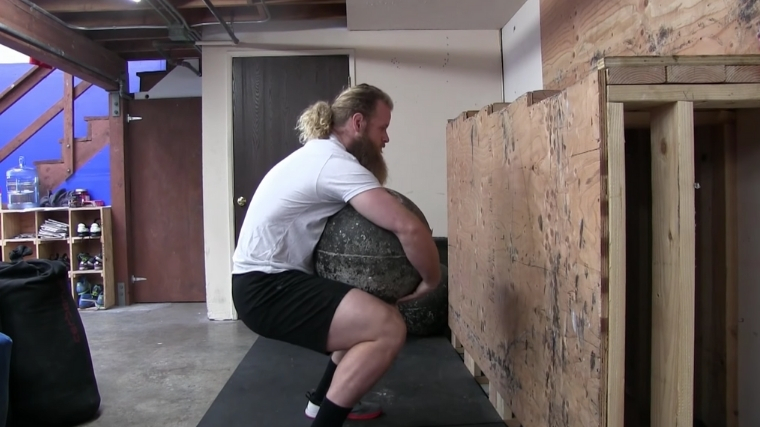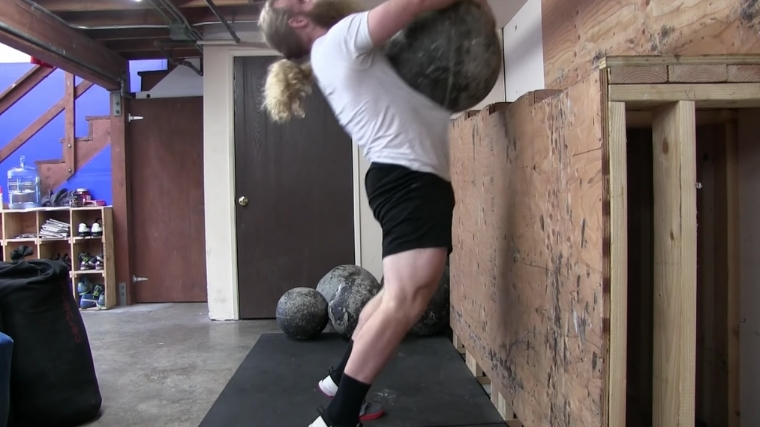Before there were weight plates and dumbbells, there were stones. Stone lifting is a universal feat of strength recognized by people everywhere. Scotland is home to the famed Dinnie stones. Iceland contains a 409-pound rock called the Húsafell. Of course, there are Atlas stones — globe-shaped hunks of concrete that strongmen and strongwomen routinely lift in competition.
Hoisting an Atlas stone takes back, core, and hip strength. It also requires perfect technique and a whole lot of grit. The payoff, however, is more full-body muscle and hip extension that will help you power through your toughest deadlift sessions. Read up on how to do Atlas stone loads below.
- How to Do the Atlas Stone Load
- Benefits of the Atlas Stone Load
- Muscles Worked by the Atlas Stone Load
- Who Should Do the Atlas Stone Load
- Atlas Stone Load Sets, Reps, and Programming Recommendations
- Atlas Stone Load Variations
- Atlas Stone Load Alternatives
- Frequently Asked Questions
How to Do the Atlas Stone Load
Below is a step-by-step guide on how to lift the stone. Be forewarned: There is only one correct way to load a stone from the floor to your lap. There are secondary techniques out there that radically increase the stress on the lower back and are inefficient. Please skip them for your own safety. There are, however, multiple ways to load a stone from one’s lap to the platform, and choosing which comes down to personal preference.
Stone weight is typically in a ratio to its size, so start with a few lighter stones. That said, once a stone weighs more than 130 kilograms (286 pounds), professional strongman Mitchell Hooper says the standard sizing for larger stones is either 20 to 22 inches. Also, it’s smart to wear long sleeves or wrap your forearms with athletic tape. The last thing you want to do is get cut up from a rough stone and have to deal with an infection.
Step 1 — Grip the Stone

Stand directly over the stone with your feet shoulder-width apart. The center mass of the stone should be between the arches of your feet. Spread your fingers wide to maximize surface contact with the stone and get your hands as far under as you can (without crushing any fingers). Extend your hamstrings until they’re fully stretched, and then drop your hips down until your back is completely straight.
Form Tip: When you bend down to pick it up, you should look like you are at the bottom of a Romanian deadlift: soft knees, bent at the waist, hips high, with a flat back.
Step 2 — Lap the Stone

Grip the stone as tightly as possible, as if you were performing a chest flye. Pull the stone up to your hips and then sit back, so the stone is in your lap. This is known as “lapping the stone.” Adjust your arms, so they’re more over the top of the stone, at the two and 10 o’clock positions. This allows you to create a shelf on your body for the stone to sit and not fall out from under you when you stand.
Form Tip: Try to get as much body and chest around the stone as possible.
Step 3 — Drive Up to Load the Stone

Pull the stone up your body as you stand up and drive your hips forward. If you’re loading the stone to a high platform, continue to pull the stone up with your arms and hold your chest high. To finish, place the stone on the platform. Be careful not to get any body parts or skin between the stone and its resting place.
Form Tip: At the peak of the movement, you should look like a collegiate wrestler executing a suplex.
Benefits of Atlas Stone Lifts
Below are a few benefits of performing Atlas stone loads.
Builds Athletic Power and Strength
The concentric phase of Atlas stone loads (aka the lifting phase) requires an extension of the hips, knees, and ankles (known as triple extension). Triple extension is a movement athletes engage in regularly. A wrestler triple-extends to suplex an opponent. Football players triple-extend to explode up and block a tackle. Heck, even the top portion of a medicine ball slam is triple extension. The Atlas stone lift is another way to train triple extension. Or if you’re a competitive strongman, the Atlas stone lift is a competition movement, so you’ll need to train with Atlas stones often.
Stronger Spine and Core
A study on the effect of strongman events on spine motion, load, and stiffness found that Atlas stones generated the lowest spine compression compared to the log and tire. (1) Though the Atlas stone lift looks like a real back-breaker, researchers discovered that because the strongman athletes curved their torsos over the stone, they kept its center of mass closer to their low backs.
[Read More: Our Favorite Forearm Workouts, + the Best Forearm Exercises]
The Atlas stone lift also has some of the largest gluteal activity, as did the quadriceps, the upper erector spinae, and many of the abdominal muscles compared to the log and tire, making it a great exercise to train the spine, core, and supporting muscles.
Develops Total Body Strength
The back, legs, core, arms, and even grip muscles play a critical role in the proper execution and completion of this lift. When training the Atlas stone lift, you can get many of the same benefits of deadlifts, with the bonus of doing front-loaded carries, planks, arm work, and grip training.
Muscles Worked by Atlas Stone Lifts
The Atlas stone load trains nearly every muscle group in the body. Below are some of the most targeted muscle groups used in the lift.
View this post on Instagram
[Related: Everything You Need to Know to Build Your First Workout Program]
Posterior Chain (Hamstrings, Glutes, Erectors)
The glutes, hamstrings, and erectors are the primary muscles used when doing the Atlas stone load. High amounts of hip extension and triple extension are used during the initial lift-off phase and the more explosive.
Latissimus Dorsi
The back muscles are trained during the Atlas stone lift and are used to initially lift the load and isometrically support the load during the later stages of the lift.
Biceps, Forearms, and Grip Muscles
The biceps, forearms, and grip muscles trained intensely during the Atlas stone load, carry, and other variations (see below). Odd object lifting can be beneficial for most lifters looking to gain arm size, strength, and improve overall carrying abilities.
Who Should Do the Atlas Stone Lift?
Below are some reasons why strength, power, and fitness athletes may benefit from performing the Atlas stone lift.
Strength and Power Athletes
- Strongman athletes: Strongmen and strongwomen literally perform Atlas stone loads in competition — sometimes in the form of a medley and sometimes a one-off max load. For that reason alone, training with Atlas stones is a must for strongman competitors.
- Powerlifters: Triple extension is a key component of a strong deadlift, one of the three competition lifts for powerlifters. If an athlete has access to Atlas stones, performing a few sets and reps toward the end of training will help you hone your extension mechanics. Also, it’ll build a stronger grip and core.
Fitness Athletes and General Fitness
When done safely and with good form, Atlas stone lifts can help anyone build more strength, increase their power, and even boost conditioning.
Atlas Stone Lift Sets, Reps, and Programming Recommendations
Here are three ways to start programming Atlas stone lifts into your routine.
[Related: How to Burn Fat for Weight Loss and More Definition]
To Increase Absolute Strength
Programming the stone for absolute strength is fairly easy. Do one to three reps for three to five sets. When doing these, an athlete should load to a lower height, around 48 to 54 inches. If a coach or athlete plans to increase the weight as much as possible during one session, then a day should be dedicated to it. If it’s a secondary movement, then do this protocol after deadlifts or squats.
To Improve Power
The focus here should be on speed and “popping” the stone off the chest at the top of the movement. Do three to six sets of three to five reps. Stick with a platform that’s 52 inches, and gradually increase the height each session.
To Improve Endurance
Atlas stones are a serious conditioning tool. The easiest way to increase your endurance with stones is to do stone loads for time. Set a timer for, say, one minute, and try to load a stone for as many reps as possible. Do one to three sets of this protocol.
Load Medley
Another common cardio protocol is a loading medley (which is often seen in strongman competitions). If you have access to platforms of multiple heights, you’ll set a stone in front of each platform. Typically the lightest stone goes to the highest platform — as weight increases, height decreases. The goal is to load all of the stones in the fastest time possible.
Every Minute on the Minute (EMOM)
Set a moderately heavy stone in front of a platform and set a timer for five to 10 minutes. Perform one stone load at the top of each minute and rest for the remaining time. You can either add time, increase the weight of the stone, or add a rep to progress this protocol.
Atlas Stone Lift Variations
Below are three Atlas stone load variations that can help improve technique, strength, and performance in the Atlas stone load.
Stone Row
The stone row is a great way to build general grip, arm, and back strength. Select a light stone and set it up the same way you would for a general stone load. Instead of lapping it, maintain the hinged position and row the stone from the floor to your chest.
[Read More: The Best Bodyweight Exercises, + Workouts and Tips From a CPT]
Stone Hold or Carry
The stone hold or carry is a great way to condition the body to maintain stability and pressure under load. After a heavy stone lift, you may find yourself needing to support the load on the chest or by putting it on your shoulder or over a target. This variation will help you learn how to properly place and support the loads for longer times, as well as improve grip, arm, back, and core strength.
[Related: The 8 Best Barbell Exercises for Mass, Strength, and Power]
Stone to Shoulder
This variation can help you increase power output and hip extension performance. To do this, use a slightly lighter weight than normal, aiming to move the stone explosively from the hip and chest to the shoulder. This forces you to drive the load higher (to the shoulder rather than to chest height), which can help you struggle to get the stone over a target.
[Related: The Best Barbells for CrossFit, Weightlifting, Powerlifting, Deadlifts, and More]
Atlas Stone Lift Alternatives
Not everyone has access to Atlas stones. Here are three exercises that you can add to your training to replicate all of (or most of) the effects of stone lifting.
Zercher or Front Squats
The benefit of these moves is that they’re both front-loaded, as is a stone load. You’ll develop back and core strength, as you do during an Atlas stone load, nut with a greater focus on leg development.
[Related: Learn the Pallof Press for Core Strength and Stability]
Clean
The clean is a power-based movement that develops hip extension and triple extension strength and performance. This is often done at higher velocities than the stone load, however it can be a great alternative if you cannot get your hands on a stone and are looking to develop triple extension power.
Front Loaded Carries
Front-loaded carries can be done with other odd objects like bags, kettlebells, slam balls, or barbells and can help develop a foundational level of back strength. This is a great option for those who do not have access to heavy stones or are just starting and unsure about the process.
FAQs
Are Atlas stone lifts beginner-friendly?
When done correctly, often with the supervision of a trained coach, the Atlas stone load can be a great way to develop a stronger back, glutes, core, and legs.
Can Atlas stone loads help me deadlift more weight?
Yea. The Atlas stone is essentially a deficit deadlift from the floor with an awkward loading phase. The load placement forces high amounts of glute and back activation as well as core strength and stability.
How often should I train with Atlas stones?
This depends on your goals and programming, but treat Atlas stones as a compound exercise. They’re taxing on your nervous system and recruit many muscles. Beginners should focus on two sessions that revolve around technique. More advanced lifters will presumably use heavier weights, and so they should stick with one session.
References
-
McGill SM, McDermott A, Fenwick CM. Comparison of different strongman events: trunk muscle activation and lumbar spine motion, load, and stiffness. J Strength Cond Res. 2009 Jul;23(4):1148-61. doi: 10.1519/JSC.0b013e318198f8f7. PMID: 19528856.
Featured image: @theworldsstrongestman on Instagram